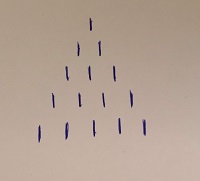An entry for the Fortnightly Topic Challenge #40.
Alice and Bob are two rational players who are playing a simple pencil-and-paper game.
In the beginning, there are fifteen small vertical bars on the paper in the form of a pyramid. Players take turns crossing over one or more bars, and the player who crosses out the last bar wins.
A turn consists of making a single horizontal stroke which crosses over at least one uncrossed bar. More than one bar can be crossed with one stroke, up to and including the whole row if the player so chooses. Bars that are already crossed can be crossed over again, so long as the stroke still crosses over at least one previously uncrossed bar. The game ends when all bars have been crossed, and the player who made the last move is the winner.
In the current game, Bob has just finished making his move.
What was Bob's last move?


